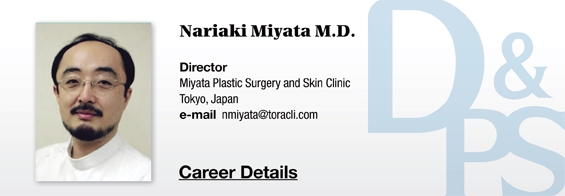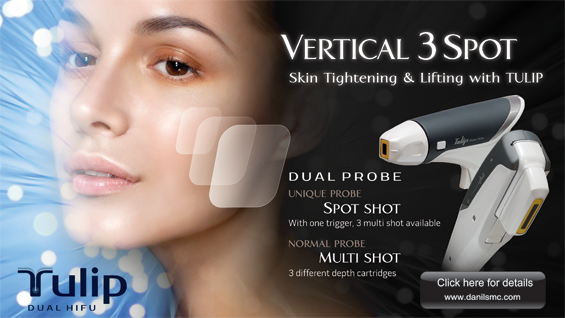
As for botulinum toxin products, Allergan’s Botox Vista was approved for glabella lines in Japan. Xeomin, Dysport, or Neuronox has not been approved yet. However, Botox Vista has disadvantages of a small vial of only 50U and high cost. Doctors can individually import other botulinum toxin products for use in areas other than glabella lines, but regulatory barriers seem to have become stronger recently.
Botulinum toxin is still not widely popular in Japan. Many patients with glum facial expressions or an awkward smile refuse treatment when I recommend botulinum toxin injection. Combining botulinum toxin with various other injections or intradermal botulinum toxin for overall facial contouring are performed by only a few doctors. I use botulinum toxin for all facial areas and often perform intradermal botulinum toxin injections.
[Advertisement] Tulip(Skin Tightening & Lifting) – Manufacturer: DANIL SMC(www.danilsmc.com)
Botulinum toxin can also be applied to hyperhydrosis of the armpit. Allergan’s 100U botulinum toxin was approved for this but there is a problem. Hyperhydrosis does not fall under aesthetic treatment and health insurance coverage is available. In other words, the price to be charged to the patient is fixed. This price is similar to the purchasing cost of the doctor and does not bring much financial benefit to the doctor’s practice. This is a major hurdle to widespread use of botulinum toxin in Japan. The number of doctors using botulinum toxin is growing but the amount used is still very low.
Japanese patients are very conservative and do not want to inject foreign materials into their face for the purpose of appearing young. They are also averse to unnatural facial expressions and only want subtle changes from aesthetic procedures. A large majority of patients visiting plastic surgeons believe that treatment with photomedical devices is sufficient. The number of doctors specializing in aesthetic treatment is far lower than that of Korea. Japanese doctors tend to focus on low-risk treatments. Aesthetic clinics do perform a lot of dermal filler or botulinum toxin injections but the total number of these procedures in Japan still fall below those of other developed countries. However, various new attempts are being made by some doctors based on foreign data. Volumizing lift is one such attempt. New techniques such as Mesobotox or water glow injection (HA injection) developed in Korea are slowly entering the Japanese market.
The impression I get from my frequent visits to Korea is that Korean doctors have widely different opinions and have individually varying injection techniques. Some doctors even develop a unique treatment method without sound theoretical data, but I think we should learn from their enthusiasm. Japanese doctors strictly adhere to techniques taught by manufacturers and do not try to develop their own techniques. Participation in academic conferences also tends to be low. Every time I visit Korea, I am amazed by the level of enthusiasm and openness of Korean doctors to new developments in their field. On the other hand, I do feel that Korean doctors pay more attention to new techniques than safety. Sometimes I see them rush to try new treatments in the hope of getting better results while ignoring small risks. As a Japanese doctor used to practicing extreme caution, I tend to worry about possibility of negative consequences.
Korean doctors are also very open to trying new materials and products. I understand that they are encouraged by competing manufacturers to try newly developed products, but I believe we should wait until long-term safety profiles are established as injectable materials may have lasting effects inside the human body. I believe most doctors in Korea do practice caution and pay attention to safety but my general impression during visiting Korea was that immediate outcome was given priority over safety.
-To be continued-




















